This week’s post doubles as an overview of animator Ben Solomon’s career, and as a look at his comic book work below—well, they are both practically the same type, anyway…
Born on August 28th, 1914 in Brooklyn, New York, Ben Solomon attended Isaac Remsen Junior High and Murray Hill Industrial High School in New York, before studying advertising art at Cooper Union, where he was awarded eight medals of merit for various works in the arts. Solomon started his professional career as a show card writer before he joined Max Fleischer’s studio in 1933 as an in-betweener. While he learned the animation process at Fleischer, he taught poster art in an East Side Settlement House.
Solomon also initiated the notion of an in-house studio newsletter, Fleischer’s Animated News, first published in December 1934 and ran until April 1937, a month before the strike.
By October 1936, Solomon was promoted to assistant animator and continued to work in this position after the studio relocated and settled in Miami. Late in the production of their first feature Gulliver’s Travels, he worked as an assistant to Shamus Culhane. In his autobiography Talking Animals and Other People, Culhane described Solomon in Miami as “a voluble Brooklynite who puffed all day at luscious Havana cigars in a transport of happiness,” since he was unable to afford such luxuries in New York. When he was promoted as a full animator, he worked in Roland Crandall’s unit where he received his first screen credit on the 1940 Popeye cartoon Shakespearian Spinach (1940). Shortly after, he shifted to Tom Johnson’s unit, where he remained until the studio was acquired by Paramount and changed to Famous Studios.
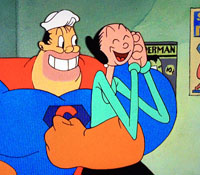
“She-Sick Sailors” (1944)
While a few animators at Famous were drafted during the war, Solomon had nerve damage in his right arm and was limited to using his left hand, which exempted him from military service. Solomon’s departure from Famous Studios on October 26, 1945 had many factors; his daughter Lois Grabash claimed he was laid off to accommodate returning servicemen. Other sources assert the studio dismissed him, along with Woody Gelman, due to their pro-union activities and sentiments. Solomon went back to drawing comic book stories for Hillman Periodicals’ Punch and Judy Comics. (Here is an example of a few scenes from the Popeye cartoons animated by Solomon, compiled by Bob Jaques.)
Solomon and Woody Gelman met each other at Fleischer, where Gelman started in 1937. He also delved into comic book work but as he recalled in a 1972 interview, “Page rates were unbelievably low. I think we were paid $5-$10 a page for all the drawing and $1 a page for the writing.”
In 1946, Solomon convinced Gelman to leave Famous and the two decided to form their own business together, which they established as Solomon & Gelman Inc., a general art studio located at 230 West 41st Street (later 247 W 46th Street.) In their business, Solomon was considered the better artist of the team and Gelman was deemed the better writer and “idea man.”
Solomon & Gelman also continued to produce their own individual freelance comic book work, including scripts for the Dodo and the Frog series written by Gelman for DC. The company grew to specialize in producing cartoon and comics-oriented advertising. For instance, Solomon and Gelman created ads for Popsicle Pete, a mascot character for the popular ice cream treat for the Joe Lowe Corporation. (The character was previously introduced on the Buck Rogers in the 25th Century radio program in 1939.) The studio employed many comic book industry freelancers and produced comic book ad pages as well as promotional comics. Solomon & Gelman Inc. also published a series of illustrated pulp adventure books for kids called The Triple Nickel Library.
During the 1950s, Topps Chewing Gum Company— located in Bush Terminal on 254 36th Street in Brooklyn—became Solomon and Gelman’s biggest client. With freelance artist Wesley Morse, the two created the Bazooka Joe and his Gang comic wrapper mascots for Topps, which enjoyed a long run until 2012. By 1952, Solomon & Gelman created and designed the modern baseball card format along with Topps executive Seymour “Sy” Berger. Probably around 1955, Topps hired the two on an exclusive basis, with Solomon as the head of the Art Department supervising the production end of the business, as well as interactions between printers and suppliers. Gelman became head of the New Product Development department, overseeing the creative talent.
Under Solomon and Gelman, Topps branched out from producing penny “change maker” chewing gum and Bazooka bubble gum slabs to an extensive line of paper novelties, gimmicks, and most importantly, trading cards. The two also hired other artists formerly associated with Famous including animator/story man Larry Riley and background painter Bob Little. After Gelman passed away in 1972 1978, Solomon continued to work for Topps, with Ted Moscowitz as his second-in-command. Mark Newgarden, who helped create the popular Garbage Pail Kids trading cards and other series for the New Product Development department in the 1980s, described Solomon as “a hard-boiled, no-nonsense kind of guy with a classic B-movie Brooklyn accent.” Mark also mentioned that he ruled the art department in a fashion that reflected Depression-era working methods. “There were stories that as late as the 1970s, his department had to turn in their pencil stubs at the end of the day as well as to sign out and return their X-Acto blades.”
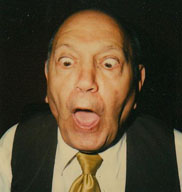
Solomon posing for DINOSAURS ATTACK trading card. Photo by Gary Gerani.
Solomon retired from in the 1990s after many decades working for Topps. As Mark states, “He was by far the most senior person working there. I think the execs were all afraid to tell him it was time to go.” A short time later, Topps was relocated to downtown Manhattan. When Gary encountered Solomon, “he seemed frailer, but just as cantankerous, sure of himself, and full of life.” On October 3, 2005, he passed away at the age of 91.
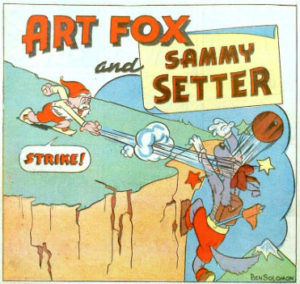 Here are examples of Solomon’s comic book stories from the 1940s. Enjoy!
Here are examples of Solomon’s comic book stories from the 1940s. Enjoy!
• “Johnny Sparrow” —Happy Comics #2 (October 1943)
• “Art Fox and Sammy Setter” —Happy Comics #2 (October 1943)
• “Bango Bear” —Ha Ha Comics #3 (December 1943)
• “Patty Plump Buys a Present”—Giggle Comics #5 (February 1944)
• “Buttons Rabbit and Officer Hippo” —Punch and Judy Comics #11 (June 1946)
• “Dumb Bunny and Officer Hippo”—Punch and Judy Comics #13 (August 1946)
(Thanks to Mark Newgarden, Bob Jaques, and Gary Gerani for their help.)


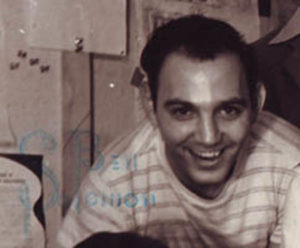
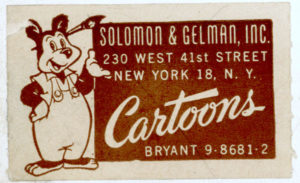
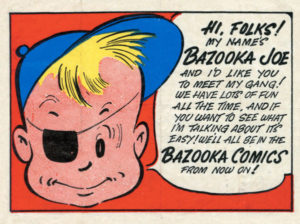
 DEVON BAXTER is a film restoration artist, video editor, and animation researcher/writer currently residing in Pennsylvania. He also hosts a
DEVON BAXTER is a film restoration artist, video editor, and animation researcher/writer currently residing in Pennsylvania. He also hosts a 





















































































Thank you for a wonderfully researched article on Ben Solomon,Devon Baxter. one correction:Woody Gelman died on Feb.9,1978, not 1972.
Fabulous- I have been looking for more on Ben for years as info seems hard to come by. Woody was more well known but both of them were constantly ahead of the times and their animation based association proved to be enduring and a vital part of 20th century pop cumture.
David, I have the “last” penciled drawing that Ben drew for me, before he passed away, of Bazooka Joe. If you are interested in a purchase, or can tell me where to go to get what’s true value is worth, let me know.
He also drew me a few more originals of other cartoon figures, as well. Thank you.
MICHAEL C. EVANTE mikeevante@aol.com
Ben Solomon was my grandpa’s uncle, and my whole family refers to him affectionately as “Uncle Benny”. I wanted to research him a bit and this is the best place I could find for good info. Thanks!
I worked at Topps in the late 1970’s and Ben Solomon told me he had worked on Popeye cartoons – which at the ripe old age of 20 I didn’t completely comprehend the significance of this person. I worked in the bullpen at Bush Terminal under Ted Moskowitz – and I soon became aware of some of the great artists that had passed there before me. I could go on and on about the place – but it’d probably bore most anyone. It was nice to read about the place where I started my career as an artist . . .